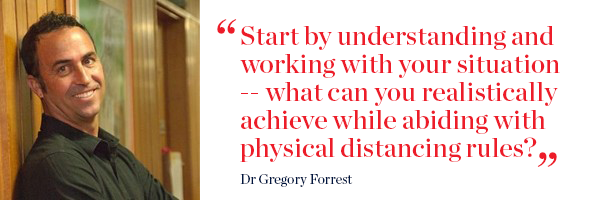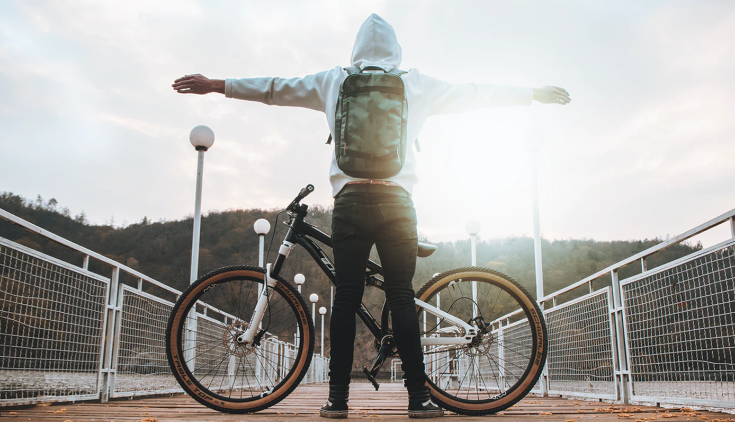April 15, 2020
Maintaining health and well-being in a time of physical distancing
As we enter another week of remote teaching, learning and physical distancing it’s important to stay focused on ourselves as much as we are on our work and families. One big question at the moment is how do we maintain our health and well-being, both mentally and physically, during this period? Dr Greg Forrest from the Pedagogical Laboratory for Physical Education and Sport within the School of Education at UOW shares his tips on forming lasting habits with ease.

You might find that you have the time to begin some new things, especially exercise programs, and you may be tempted to start on a course of purchasing a multitude of new apps and subscriptions that promote a new and improved lifestyle. I call these ‘fads’. The key to either starting or maintaining our well-being is establishing good habits so before reaching for a fad, do the groundwork and set yourself up for better success.
We’re fortunate to have a whole range of things that we do as normal everyday practice that we can use to develop some good well-being habits from a physical perspective. Here are some tips to get you thinking and moving but please start with small steps -- avoid grandiose plans to change your whole profile and remember, avoid social media and watching people run marathons around their apartment complexes (unless you’re a seasoned marathon runner).
Start by understanding and working with your situation -- what can you realistically achieve while abiding with our physical distancing rules? Wollongong has many physical spaces that are still accessible to us so aim to get outside at least once a day for a walk, run or cycle, regardless of the weather. It can be just as invigorating walking in the rain and wind as on a sunny day. Vary the time of day that you venture out and make an effort to take in the subtle changes in your environment. Use a journal for your activity in whatever format works for you -- writing, audio diary, photography, drawing, poetry, or simple conversations with others and then vary it from time to time. There is no set distance of value, just do what you can. A short walk is better than no walk, 10 steps are better than no steps, and if you miss a day just go the next.

You can also make use of the simple things you do every day to help develop habits. We have so many routine activities that we can use as habit forming opportunities. Just look at how washing our hands has become a habit (even though there are some serious health imperatives, although ironically, there always were).
Let’s start. We all visit the bathroom regularly every day, correct? So why not try some new bathroom activities while you’re there? For instance, every time you visit your bathroom do two incline push-ups against your vanity or bathtub. Place your hands on the bench shoulder-width apart, feet together. Your body should start at about a 45-degree angle or however your space permits. Breathe in on your way down and out as you push back up. Too hard? Move your feet in closer. Too easy? Increase your reps to five or 10 or do them from the floor. By adding in this simple body weight exercise you’ll be improving your bone density and strength.
Our working part of the day is important too.
We’re all no doubt sitting behind a screen for the greater part of our day and with this comes postural pains such as a stiff neck or tight shoulders. If you were to observe yourself side on you would see that your chin leans forward towards your screen, so every time you shift from typing to using your mouse pull your chin right in to make a double chin, hold it for three seconds and release. Do this as many times as you like and try to make it something you do each time you reach for the mouse. For your shoulders, add in a backwards shoulder roll to loosen them up and get your body in motion. And when you’ve finished your work, try five foot lifts – keep your heel grounded and raise your feet and toes upwards. This is great for ankle mobility.
Snack time! We all need to eat throughout the day, some more than others, so as you get up from your chair consider that you’ve just completed the second half of a squat. Well done. Now all you need to do is add in the first part. Once you’re in a standing position lower yourself down and backwards until you just touch the seat of the chair, then lift back up again. Keep your knees in line with your feet, heels firmly on the floor, and press through the balls of your feet trying not to roll in or out through your knees and ankles. The key is to not sit down on the seat, just touch it then lift back up. Hold your arms out in front for more of a challenge, lower for an easier option, or slightly touching your table for support is fine. Once you’ve mastered this why not try mixing in some one-legged stand-ups? Use your hand as a support if you need to and raise up onto your toes at the end.
Your back and core might also start to feel the effects of sitting for prolonged periods and this comes back to your abdominals. Abs are great but what’s more important are our oblique chains. These are core muscles that run across our sides from the ribs to the top of the pelvis. Every day when you wake, before you roll out of bed lay flat on your back and bend your knees to 45 degrees keeping your feet flat on the mattress. Feel that you are pushing your stomach out and up, not sucking it to the backbone, and press your back flat into the bed -- you should not be able to fit a hand between your back and the mattress. Hold and count to five, then release. The muscles in the front of your legs should be ‘switched off’ and loose. Start with two each morning and if you find yourself sitting or lying on the ground throughout the day, repeat.
Here's some more simple and effective activities to keep your habit forming moving in the right direction.
As you walk through a doorway (maybe not every doorway) stop in the door frame stand with your feet together and grab hold of the frame at shoulder height, palms to the frame, backs of your hands facing each other. Your elbows will be bent and raised. Slowly lean backwards until your arms are straight then pull yourself back up again.
And to cap things off after a great day, as you relax on the lounge shift your focus to your feet and lift all of your toes up, spread them out, hold for five seconds, then lower them back to the floor. Easy, perhaps, but don’t forget that little toe as well. Repeat, and then pick another body part for a similar challenge -- the ‘Spock’ salute, wiggle your ears without moving your face, or raise one eyebrow at a time. This is some great mental stimulation to wind up the day.
You need to nurture and develop your habits, that’s the key. It might end up being as important as hand washing in the long-term. Next time … double ball wall tosses and learning how to three-ball-juggle your own home-made juggling balls. And if you are really adventurous, go and dig out your old ‘jacks’ or order some online.
Dr Gregory Forrest works in the Pedagogical Laboratory for Physical Education and Sport, and is the Academic Program Director, Health and Physical Education and Senior Lecturer Physical and Health Education within the , Faculty of Arts, Social Sciences and Humanities, University of Wollongong.
